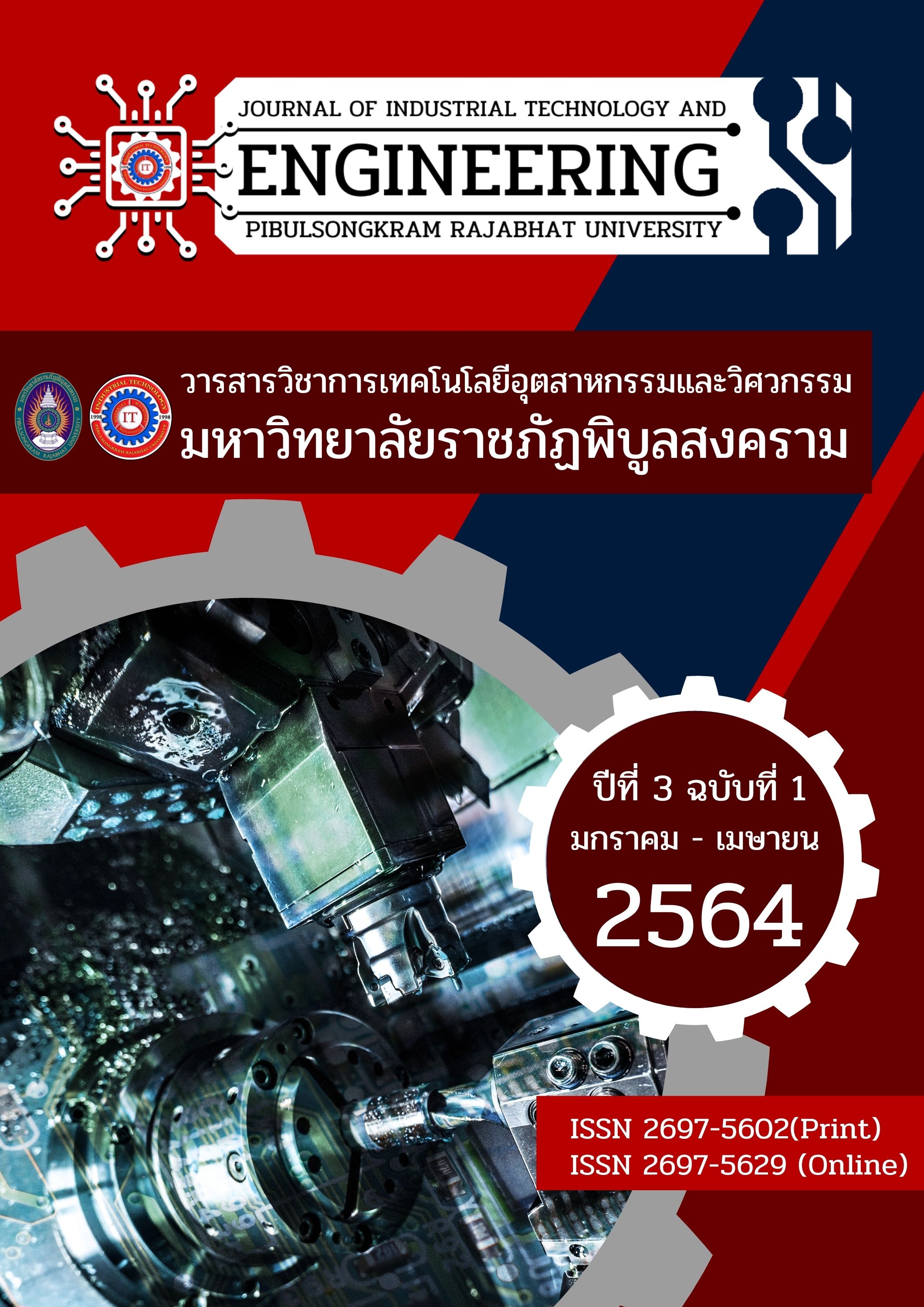การศึกษาระบบเทอร์โมอิเล็กทริกเพื่อควบคุมอุณหภูมิสำหรับการจัดส่งอาหาร
คำสำคัญ:
เทอร์โมอิเล็กทริก, ความปลอดภัยด้านอาหาร, การถนอมอาหารบทคัดย่อ
งานวิจัยนี้มีวัตถุประสงค์เพื่อการศึกษาระบบเทอร์โมอิเล็กทริกเพื่อควบคุมอุณหภูมิสำหรับการจัดส่งอาหาร โดยภาชนะถนอมอาหารถูกออกแบบเพื่ออุ่นอาหารสำหรับเพิ่มความปลอดภัยทางด้านอาหารในธุรกิจฟู้ดเดลิเวอรี่ อุปกรณ์หลัก คือ เทอร์โมอิเล็กทริกโมดูล รุ่น THC1-12706 จำนวน 2 โมดูล และวงจรตัดต่ออุณหภูมิ รุ่น FK934 กำหนดเงื่อนไขให้ชุดระบายความร้อนภายในภาชนะเท่ากับ 70 °C โดยทำการทดลองและเก็บข้อมูลแบ่งออกเป็น (1) การวัดอุณหภูมิสูงสุดของชุดกระจายความร้อนภายในภาชนะถนอมอาหาร อุณหภูมิเฉลี่ยที่อาหารตัวอย่าง 2 ประเภท อาหารประเภทแห้ง(ข้าวผัดไข่) และอาหารประเภทน้ำ(ต้มจืด) โดยการทดลอง ใช้ภาชนะถนอมอาหารกับไม่ใช่ภาชนะถนอมอาหาร (2) วัดการใช้พลังงานของภาชนะถนอมอาหาร
ผลการทดลองพบว่า (1) ชุดกระจายความร้อนภายในมีอุณหภูมิสูงสุด 72.97 °C อุณหภูมิเฉลี่ยเท่ากับ 68.27 °C ค่าเบี่ยงเบนมาตรฐาน 0.47 อาหารตัวอย่างประเภทแห้ง ข้าวผัดไข่ใช้ภาชนะถนอมอาหารมีอุณหภูมิเฉลี่ยเท่ากับ 56.44 °C ไม่ใช้ภาชนะถนอมอาหารอุณหภูมิเฉลี่ยเท่ากับ 42.29 °C อาหารตัวอย่างประเภทน้ำ ต้มจืดใช้ภาชนะถนอมอาหารมีอุณหภูมิเฉลี่ยเท่ากับ 55.83 °C ไม่ใช้ภาชนะถนอมอาหารอุณหภูมิเฉลี่ยเท่ากับ 42.41 °C (2) พลังงานไฟฟ้าที่ใช้มีค่ากระแสไฟฟ้าเฉลี่ยเท่ากับ 3.68 A และมีค่ากำลังไฟฟ้าเฉลี่ยเท่ากับ 44.13 W พลังงานไฟฟ้าที่ใช้ประมาณ 0.04 kW-h การทดลองใช้ภาชนะถนอมอาหารสามารถอุ่นอาหารได้ที่อุณหภูมิมากกว่า 50 °C ทำให้อาหารไม่เสียรสชาติและยังสามารถทำลายแบคทีเรียที่อุณหภูมิ 50 °C ได้ในขณะทำการขนส่งอาหารมีความเหมาะสมในการนำไปใช้ในตลาดธุรกิจฟูดเดลิเวอรี่อยู่ในเกณฑ์ด้านความปลอดภัยทางอาหารช่วยเพิ่มความปลอดภัยให้กับผู้บริโภคมากขึ้น
เอกสารอ้างอิง
กันยา หว่านณรงค์. (2555). แบคทีเรียในอาหาร. ว.เพื่อการวิจัยและพัฒนา องค์การเภสัชกรรม, 19(2), 12-15.
ทัตพงศ์ แผ่เกียรติวงศ์, ยศธร ทองคา และวชิรพล แสนโซ้ง. (2554). เครื่องอุ่นอาหารด้วยแสง. โครงงานคณะวิศวกรรมศาสตร์ ศรีราชา. มหาวิทยาลัยเกษตรศาสตร์ วิทยาเขตศรีราชา, ชลบุรี.
Adams, M.R., & Moss, M. O. (2008). Food microbiology (3rd edition). Cambridge: The Royal Society of Chemistry.
Amir, Y.F., & Aliakbar, A. (2014). Analysis of a symbiotic thermoelectric system for power generator and liquid preheating. Applied Thermal Engineering, 71, 501-507.
Baskentli, S., Block, L., & Morrin, M. (2020). The serving temperature effect: Food temperature, expected satiety, and complementary food purchases, Appetite, 160, 1-12.
Bimrew, T.A., Xiaobing, L., & Jiawei, Y. (2013). Effects of temperature non-uniform it over the heat spreader on the outputs of thermoelectric power generation system. Energy Conversion and Management, 76, 533-540.
Casano, G., & Piva, S. (2011). Experimental investigation of performance of thermoelectric generator. Experimental Thermal and Fluid Science, 35, 660-669.
Ekburanawat, J. (2019). A Thermoelectric Pan for Heating and Chilling Application. Master of Engineering. Electrical Engineering. RMUTI Journal Science and Technology, 12(3), 96-109.
Jino, P., Pinthong, T., & Maimun, K. (2014). The study of heat to water and cold to water from thermoelectric with solar cell. Burapha Science Journal, 6, 231-243.
Nahmias, S. (1982). Perishable inventory theory: a review. Operations Ressearch, 30(4), 680–708
NSW Food Authority, (2009). Microbiological quality guide for ready-to-eat foods: A guide to interpreting microbiological results.
Onyeneho, S.N., & Hedberg, C. W. (2013). An assessment of food safety needs of restaurants in owerri, imo state, Nigeria. International Journal of Environmental Research and Public Health, 10, 3296--3309.
Rong, A., Akkerman, R., & Grunow, M. (2011). An optimization approach for managing fresh food quality throughout the supply chain. International Journal of Production Economics, 131(1), 421–9.
Sinthalai, S. (1977). Food Theory. Bangkok: Bamrungnukulkit Printing House.
Sitawan, T. (2015). Thermoelectric Technology. Bangkok: Chulalongkorn University.
Sofrata, H. (1996). Heat rejection alternative for thermoelectric refrigerators. Energy Convers, 37, 269-280.
Trickett, J. (2001). The prevention of food poisoning (4th Edition), Nelsonthornes: Cheltenham.
Wang, C., Calderona, C., & Wang, Y. (2017). An experimental study of a thermoelectric heat exchange module for domestic space heating, Energy and Buildings, 1-21.



